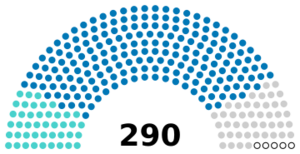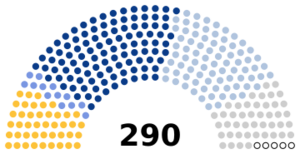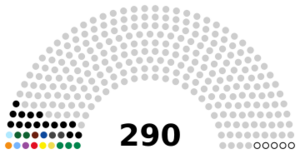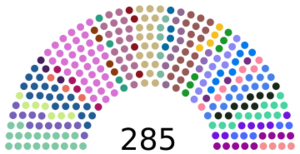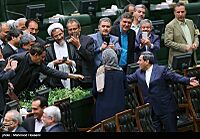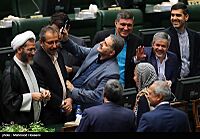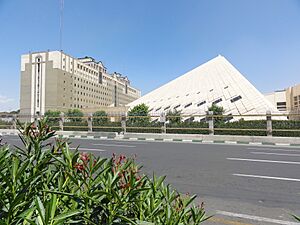Islamic Consultative Assembly facts for kids
Quick facts for kids Islamic Consultative Assemblyمجلس شورای اسلامی Majles-e Shurâ-ye Eslâmi |
|
|---|---|
| 12th term 36th Majlis |
|
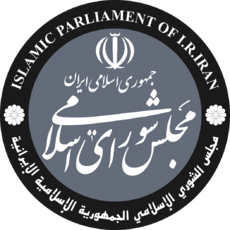 |
|
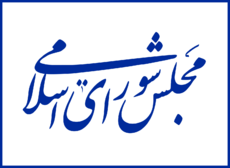 |
|
| Type | |
| Type | |
| History | |
| Founded | 16 November 1906 14 March 1980 (current form) |
| Preceded by | National Consultative Assembly |
| Leadership | |
|
Mohammad Bagher Ghalibaf
Since 28 May 2020 |
|
|
First Vice
|
Ali Nikzad
Since 27 May 2025 |
|
Second Vice
|
Hamid-Reza Haji Babaee
Since 27 May 2025 |
| Structure | |
| Seats | 290 |
|
Political groups
|
By faction
By coalition
Government (43)
VNC (43) Confidence and supply (119) CCIRF (106) UCIRF (13) Opposition (79) Vacant (5) By party
FIRS (15)
ICP (3) PJPII (2) SPIR (2) SDIR (1) DJP (1) FCETII (1) ISE (1) IAPI (1) ECP (1) MDP (1) UIIPP (1) AFIL (1) Independents (254) Vacant (5) |
|
Length of term
|
4 years |
| Elections | |
| Qualified majority two-round system | |
|
Last election
|
1 March and 10 May 2024 |
|
Next election
|
2028 |
| Meeting place | |
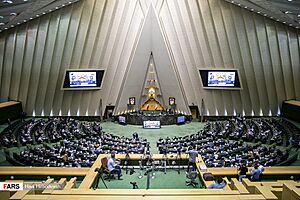 |
|
| Islamic Consultative Assembly Baharestan Tehran Iran |
|
| Website | |
| https://en.parliran.ir/ | |
| Constitution | |
| Constitution of the Islamic Republic of Iran | |
The Islamic Consultative Assembly (Persian: مجلس شورای اسلامی, romanized: Majles-e Shurâ-ye Eslâmi), also known as the Iranian Parliament, is the main law-making body of Iran. It is a unicameral legislature, meaning it has only one chamber or group of representatives. Currently, 290 representatives work in the parliament. This number increased from 270 seats after the election on 18 February 2000.
Contents
History of Iran's Parliament
How the Parliament Changed Over Time
After the Iranian Revolution in 1979, the Senate of Iran (which was like a second chamber) was removed. Its duties were taken over by the Guardian Council. This meant Iran's law-making body became a single chamber. In 1989, the "National Consultative Assembly" officially changed its name to the "Islamic Consultative Assembly."
Over the years, the parliament's role has changed. It started as a place for important people to discuss ideas. Later, it became more influenced by the government. Today, it is mainly shaped by members from the middle class who own property.
Leaders of the Parliament
Since the Iranian Revolution, several people have served as the Speaker of the Parliament. Akbar Hashemi Rafsanjani was the first Speaker from 1980 to 1989. Other Speakers included Mehdi Karroubi, Ali Akbar Nategh-Nouri, Gholam-Ali Haddad-Adel, and Ali Larijani. Since 2020, Mohammad Bagher Ghalibaf has been the Speaker.
A Security Incident in 2017
On 7 June 2017, a security incident occurred at the Iranian parliament building in Tehran. Another attack happened at the shrine of Ayatollah Khomeini around the same time. These events led to injuries and loss of life.
What the Parliament Does
The Islamic Consultative Assembly has the power to create laws for Iran. However, these laws must follow the country's main religion (Islam) and its Constitution.
- Making Laws: Government proposals for new laws must first be approved by the Council of Ministers before going to the Assembly.
- Investigating Issues: The Assembly can look into any important matter concerning the country.
- International Agreements: All international agreements, like treaties and contracts, need the Assembly's approval.
- Loans and Grants: If the government wants to get loans or grants from other countries, the Assembly must agree.
- Approving the Government: When a new government is formed, the President needs the Assembly's vote of confidence. This happens before the government can start its work.
- Asking Questions: Members of the Assembly can ask questions to the President or ministers about their duties. The President or minister must then come to the Assembly to answer.
- Reviewing Laws: After the Assembly approves a law, it goes to the Guardian Council. This council checks if the law follows Islamic rules and the Constitution. If there's a problem, the law goes back to the Assembly for changes. If not, it becomes official.
The Mellat Polling Center is a group connected to the Assembly's research department. It helps gather public opinions to make better laws and decisions.
Who Can Become a Member?
To become a member of the parliament, candidates need to meet certain requirements. They must be at least 30 years old and no older than 75. They also need a university degree (like a master's degree) or an equivalent religious education. All candidates must be born in Iran.
Members of the Parliament
Currently, there are 290 members in the Iranian Parliament. They are elected for a four-year term. Five of these seats are specially reserved for religious minority groups. Two seats are for Armenians, and one each for Assyrians, Jews, and Zoroastrians. About 8% of the parliament members are women. This is less than the global average of 13% for women in parliaments worldwide.
The parliament has important powers. It can remove government ministers through special votes. It can also remove the President from office if there is serious misconduct. While the government usually suggests new laws, individual parliament members can also propose them. Members can also suggest changes to laws being discussed. The parliament also helps create the national budget and approves international agreements.
All people who want to run for election, and all new laws proposed by the Assembly, must be approved by the Guardian Council. Candidates must promise to follow the Iranian constitution.
Representing Different Areas
Electoral Districts of Iran
The parliament has 207 different areas, called constituencies, that its members represent. This includes the five special seats for religious minorities. The other 202 areas cover one or more of Iran's 368 counties. Each member represents a specific part of the country.
Parliament Leadership
Choosing the Speaker
Members of Parliament choose their Speaker and Deputy Speakers. This happens during the first meeting of Parliament each year, usually in May. They serve for a one-year term, and the same person can be chosen again.
The current Speaker of Parliament is Mohammad Bagher Ghalibaf. The First Deputy Speaker is Ali Nikzad, and the Second Deputy Speaker is Hamid-Reza Haji Babaee.
Parliament Committees
The Islamic Consultative Assembly has many specialized committees, also called commissions. These committees focus on different topics to help create better laws and policies. For example, there are committees for:
- Education, Research, and Technology
- Social issues
- Economy
- National Security and Foreign Policy
- Energy
- Health and Medical issues
- Industries and Mines
- Cultural matters
- Legal issues
- Agriculture and Environment
- Joint Commission of the Islamic Consultative Assembly
- Special Commission of the Islamic Consultative Assembly
- Integration Commission of the Islamic Consultative Assembly
- Investigative Commission of the Islamic Consultative Assembly
- Internal Regulation Commission of the Islamic Consultative Assembly
- Article 90 of the Constitution Commission of the Islamic Consultative Assembly
- Education, Research and Technology Commission of the Islamic Consultative Assembly
- Social Commission of the Islamic Consultative Assembly
- Economy Commission of the Islamic Consultative Assembly
- National-Security and Foreign-Policy Commission of the Islamic Consultative Assembly
- Energy Commission of the Islamic Consultative Assembly
- Program, Budget and Accounting Commission of the Islamic Consultative Assembly
- Health and Medical Commission of the Islamic Consultative Assembly
- Internal Affairs of the Country and Councils Commission of the Islamic Consultative Assembly
- Industries and Mines Commission of the Islamic Consultative Assembly
- Civil Commission of the Islamic Consultative Assembly
- Cultural Commission of the Islamic Consultative Assembly
- Judiciary and Legal Commission of the Islamic Consultative Assembly
- Agriculture, Water, Natural Resources and Environment Commission of the Islamic Consultative Assembly
Cyber Incident
Before the legislative election on 1 March 2024, a cyber incident affected the Assembly's servers on February 14, 2024. The next day, the voting system was also affected. Journalists were not allowed to enter the building during this time.
How the Parliament is Made Up Today
The most recent elections for the Iranian Parliament took place on 1 March 2024. A second round of voting happened on 10 May 2024 in districts where no candidate received enough votes. Over 48,000 people registered to be candidates. About 15,000 candidates then ran for the 290 seats. These seats represent Iran's 31 provinces. The final results showed that a group called principlists won 233 out of the 290 seats.
The parliament is made up of different political groups. These groups often have different ideas about how the country should be run.
|
| Term | Composition ↓ |
||||
|---|---|---|---|---|---|
| 3rd |
|
||||
| 4th |
|
||||
| 5th |
|
||||
| 6th |
|
||||
| 7th |
|
||||
| 8th |
|
||||
| 9th |
|
||||
| 10th |
|
||||
| 11th |
|
||||
| 12th |
|
The Parliament Buildings
After 1979, the Parliament met in the building that used to be the Senate of Iran. A new building was later built for the Assembly in Baharestan Square in central Tehran. This new building is close to the old Iranian Parliament building, which was used from 1906 to 1979. After some discussions, the move to the new building was approved in 2004. The first meeting in the new building happened on 16 November 2004.
The old parliament building is shown on the back of the Iranian 100 rial banknote.
Images for kids
See also
 In Spanish: Asamblea Consultiva Islámica para niños
In Spanish: Asamblea Consultiva Islámica para niños


